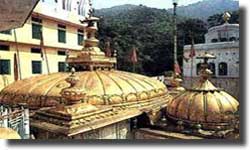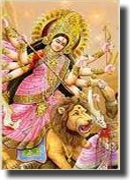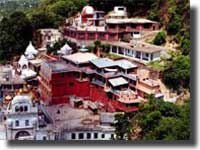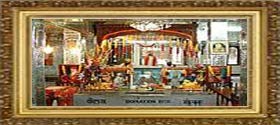Location :
Maharaja Ranjit Singh paid a visit to the temple in the year 1809. His son, Kharak Singh gifted a pair of silver plated folding doors to the temple while Ranjit Singh himself gave the gilt roof. Moreover, in the princely era, the work of the temple was managed by the Raja of Naduan. He himself appointed the temple priest. After independence, things changed a lot. The pujaris are now appointed and paid by the government. A part of the money collected by the temple is used to improve the facilities for the visiting pilgrims.
Myth behind the Temple

The gods could not foresee a calamity approaching them so they assembled before Lord Vishnu and asked him to do something to control anger of lord Shiva. As a remedy to this problem Lord Vishnu cut apart Sati's body into several pieces with the help of his Sudharshan Chakra. Wherever on earth the pieces of Sati's body fell, a shaktipeeth came up with different temples. These are the spot that are regarded as the power centre of the goddess. Jwalamukhi temple one of the form of Maa Durga is the place where the tongue of Sati fell. Here the goddess is manifested like tiny flames that burn through the fissures in the age old rock.
Who build the Temple
The temple is believed and supposed to be first built by a king who, on the complaint of a cowherd, tried to find out the place w from where a female emerged and drank the milk of the cow in those times. Since, the king was aware of the legend of Sati, as well he continued his search for the place and finally succeeded. Kind began construction of the temple there and employed priests to perform pujas. Later in times the great Pandavas came and carried out some renovation work in the temple.Significance of the temple

The Flames emit out from several other point in the pit. They are nine in total which represent the different form of the goddess - Saraswati, Annapurna, Chandi, Hing Laj, Vindhya Vasini, Mahalakshmi, Mahakali, Ambika and Anjana. There are two lions in front of the temple. The Jwalamukhi temple is dedicated to the Goddess of Light. The temple is made up of a dome and peak like pinnacles. The flame is believed to represent the Goddess.
Time to Visit

The 'Gorakh Tibbi' is the centre of the Gorakhpanthi Naths which is placed near the Jwala Kund. All kinds of entertainments along with Folk-dances, songs, plays, wrestling matches and athletics are the attractions of the fair. month April and later October is the best time to visit the Jwalamukhi Temple.
Rules and Rituals of the temples
In Jwalamukhi Temple during the whole day, there are about five aartis conducted in the temple. The first aarti is performed early at 5am in the morning called as the Mangal aarti. The next aarti is done at the time of sunrise called Panjupchaar Pujan. At around midnoon, it is time for yet another aarti which is named as the Bhog Ki Aarti. The evening aarti at around 7 pm is simply called aarti while the last one at around 10 pm is known as the Shaiyan ki aarti.
The last aarti of the day in the Jwalamukhi Temple is very much unique since it is only here that such an aarti is conducted. During the aarti, the bed of the Maa Jwala goddess is decorated with beautiful dresses and jewellery. The aarti is performed in two parts firstly the one is in the main temple while the second one is performed in the sejabhavan. Slokas from 'Sondarya Lahri' by Shri Shakracharya are through the day recited throughout the aarti for the auspicious and scared shrine of Maa Jwalamukhi. Havan is also performed once a day and parts of Durga Saptarshi are recited during it. Offerings made before the goddess in puja include bhog of rabri or thickened milk, misri or candy, seasonal fruits and milk.
Accommodation near the Mosque
 |
Nearby tourist places to Jwalamukhi Temple
Chamba Dalhousie Dharamshala Shimla |
The deity is offered Bhog of Rabri or thickened milk, Misri or candy, seasonal fruits, milk and arti is done. Devotees coming to the Jwalamukhi temple can either buy prashad from any of the nearby shops of the temple or bring in their own prasad from home. Usually, the prasad that is offered to the deity include pan, supari, dhawaza, narela, loung and elaichi. |
Transport Facilities at the Temple
- For tourists the closest airport is at Gaggal which is around 50 km away
- The nearest railhead is a narrow gauge one at Ranital, 20 km away. The Chandigarh airport and railway station are at the distance of about around 200 km. Trains from Pathankot to Joginder Nagar leave at 2.15 h, 4.50 h, 8.50 h, 9.35 h, 13.10 h, 16.00 h and reach Jwalamukhi road in 3 h and from there by bus to visit Jwalaji.
- The Jwalamukhi temple is also well connected by road. State transport buses from cities of Punjab and Haryana are available.
- Taxis are also there to take you to the Jwalamukhi temple. Frequent buses pass through Kangra, distance 54 km and takes 2 hour. Kangra is 36 km away from Jwalamukhi. Buses are also coming from Pathankot (123 km), Mandi (171 km), Manali (281 km). Simla (321 km), Palampur, Joginder Nagar and from several places of North India.



